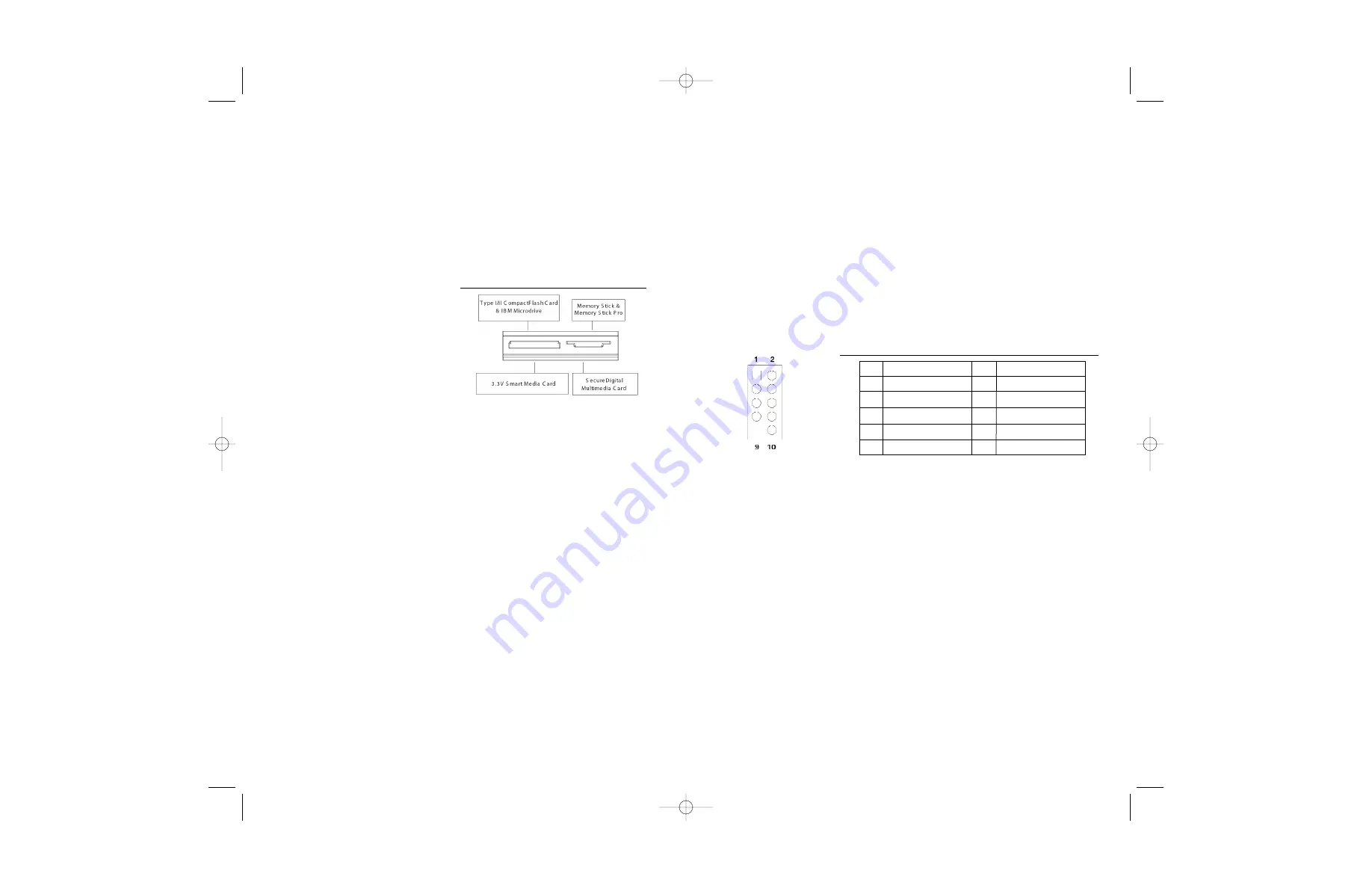
4
with Pin 5 blocked. To connect the card reader to your motherboard, follow the
directions that explain how to connect the internal USB connector to your moth-
erboard headers. (See the Connecting the USB ports section of this manual.)
Note:
Due to the blocked 'key' pin, you will need to use a motherboard USB
header row with only 4 pins.
If you are a brainiac who plans to run Linux Kernel 2.4.0 or higher, you do not
need to install a separate driver. But you will need to edit the kernel code.
Please see the file LINUX_HOWTO.txt on the Setup CD for editing instructions.
Connecting the IEEE 1394 (FireWire®, i.Link®) Port
There are six wires with connectors attached to the front-mounted IEEE 1394
port of your case. They consist of 2 sets of twisted pair cables: TPA (Twisted
Pair A) and TPB (Twisted Pair B), a power cable (VP), and a ground cable (VG).
Note: DO NOT connect the IEEE 1394 connectors to your motherboard's
USB header. This could cause permanent damage to your motherboard.
1. Locate and identify the pin-out of the IEEE 1394 port on your motherboard.
2. Connect the VP connector to the power pin.
3. Connect the VG connector to the ground pin.
4. There are two sets of data pins. Each set consists of a plus and a minus
pin. They are usually marked as TPA+ and TPA-, TPB+ and TPB-.
a. Connect the TPA+ connector to the TPA+ data pin and TPA- connector
to the TPA- data pin.
b. Connect the TPB+ connector to the TPB+ data pin and TPB- connector
to the TPB- data pin.
Connecting the Audio Ports
There is an Intel standard 10-pin connector (with 7 individual wires with
connectors) coming out from the front panel speaker and microphone connection.
If your motherboard supports Intel's standard onboard audio connector, you can
plug in the 10-pin connector directly onto the board. For non-Intel standard
audio connection, you need to plug the 7 individual connectors to the mother-
board. See instruction below:
Locate the internal audio connectors from your motherboard or sound card.
Consult your motherboard or sound card manual for the pin-out positions.
1. Microphone Power Pin: Connect the MIC connector to this pin.
2. Input Pin: Connect the MIC-BIAS connector to this pin.
Pin Signal Name Pin Signal Name
1
TPA+
2 TPA-
3
Ground
4 Ground
5
TPB+
6 TPB-
7
+12V (Fused)
8 +12V (Fused)
9
Key (no pin) 10 Ground
Pin Assignments for Front Panel IEEE 1394 Connector:
3
standard. If you're unsure of your motherboard's layout, please contact
technical support at your motherboard's manufacturer.
2. Connect the 5-pin USB connector so that the red wire is on Pin 1 (Power,
or +5V). The second header may be reversed (Power pin at the opposite
end of the row) so be careful when you plug in both connectors.
8-in-1 Card Reader/Writer
The card reader/writer includes an internal high-speed (480Mbps) USB 2.0
interface and external SM, SD®/MMC, MS and CF Socket interfaces. It supports
hot-swapping and Mass Storage Class Drive, and allows you to use different
sockets at the same time. The following memory cards are supported:
- Compact Flash® (CF) Type I
- Compact Flash® Type II
- IBM Microdrive® (MD)
- Smart Media® (SM)
- Memory Stick® (MS)
- Memory Stick Pro®
- MultiMedia Card® (MMC)
- Secure Digital Card® (SD®)
Important!
Read the following instructions carefully and follow the installation
method appropriate to your operating system.
If you plan to run Windows® 98/98SE or Windows® 2000 SP2 or lower:
1. Before you physically connect the card reader to your motherboard, you
must load the driver on the included CD. This means that you'll have to
complete the system assembly process before you connect the card reader
to the motherboard. Once you've assembled your system, proceed to
Step 2 (below) to complete the card reader setup.
2. Install Windows® according to the instructions Microsoft® provides. Once
completed, continue with step 3.
3. Put the driver CD into your CD drive, click on 'My Computer,' and then
click on the CD drive icon. Run "Set Up" to install the driver.
4. Turn off your computer and unplug the power cord. Remove either side
panel of your Aria (if you closed it when you finished the assembly).
5. On the cable attached to the 8-in-1 card reader, you'll find a 5-pin internal
USB connector with Pin 5 blocked. To connect the card reader to your
motherboard, follow the directions that explain how to connect the internal
USB connector to your motherboard headers. (See the Connecting the USB
ports section of this manual.)
Note:
Due to the blocked 'key' pin, you will
need to use a motherboard USB header row with only 4 pins.
6. Close the open side panel. Your card reader is now installed.
If you plan to run Windows® 2000 SP3 and above, Windows® XP, or Windows® ME,
you do not need to install a separate driver. You may connect the card reader to
your motherboard at any time during the system assembly process. On the cable
attached to the 8-in-1 card reader, you'll find a 5-pin internal USB connector
The card ports are arranged as follows:
ARIA_Int_Manual.qxd 2/27/2004 2:50 PM Page 8




